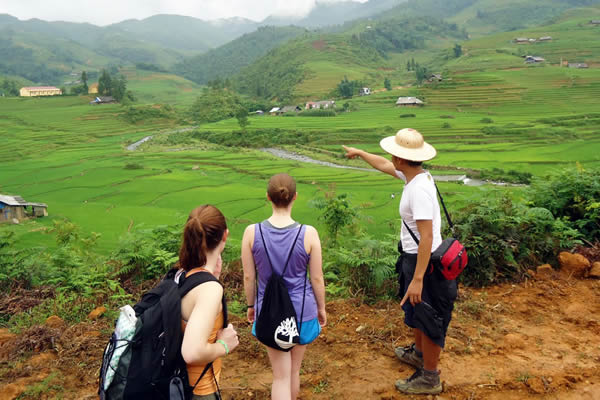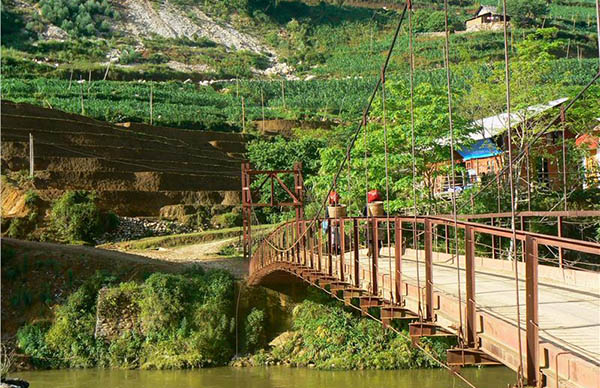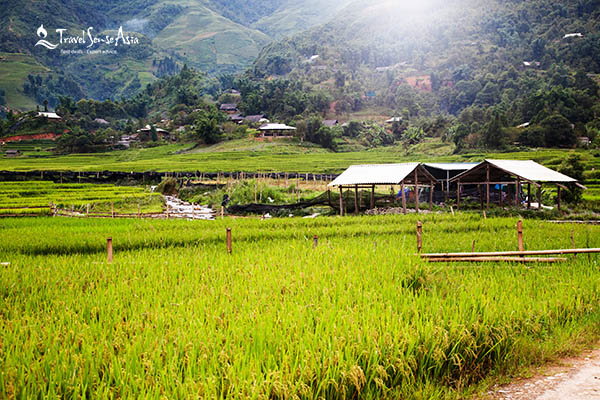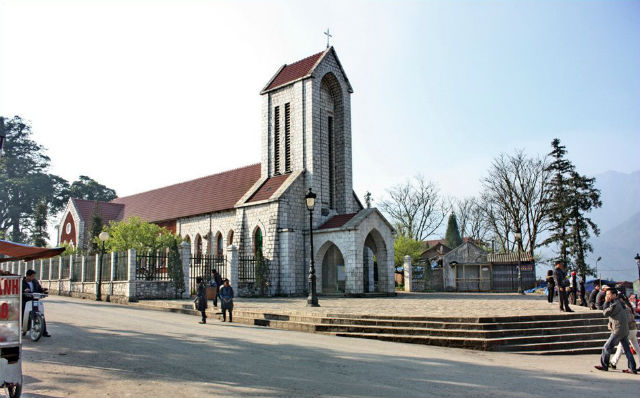Sapa is famous for the rice fields, natural world wonder, the mysterious minority cultures in the north Vietnam and Fansipan peak. If you’re traveling all the way up to Sapa, you will enjoy the best trekking in Sapa from some essential tips. It is a great chance for someone who wants to grace the rice terraces with sweeping mountain vistas. It was incredibly picturesque, the cool mountain air was refreshing, and it was just great to be out exploring nature.
Take a local guide
There are trekking in a whole day or even half-day excursions (to Cat Cat Village) that you can do by yourself. However, if you want to spend a few days in the mountains, it is better to be accompanied by a local guide who is familiar with the terrain, weather changes, and the best vantage points in trekking trail. Local travel agencies offer English-speaking tour guide at prices ranging between USD 30-50 or you can go with a local person who can speak English and this is the best way to discover the daily life of ethnic minorities.
Small luggage
The guide is not a carrier, so only bring what is absolutely necessary for you. Remember, your bag will be heavy when you wear trekking.
Lots of water
During the trekking, you will be thirsty. It’s really horrible to realize that you just drank the last drop of your water and there are still another two hours of walking ahead. To not die of thirst, take plenty of water with you.
And finally, do not forget your camera! The landscape of Sapa and the surrounding area is very beautiful so make sure that you bring along your camera and the battery is fully charged. Thus, you will keep the album of the memory trip in Sapa Vietnam.
To get to Sapa
Take a train from Hanoi to Lao Cai. Lao Cai is a small town located near the Chinese border, it is just 38 km from Sapa. There is a bus service connecting Hanoi and Lao Cai, but the night train is by far the most convenient way. The trip to Lao Cai is a night journey which starts from Hanoi at night and arrives at the Lao Cai in the early morning. Then, you will reach Sapa from the station by shuttle bus and commence your trekking tour
Have a detailed trekking plan
On the first day
Cat Cat village
The first destination on the best trip in Sapa is Cat Cat village. After a 2 kilometers journey from Sapa town, you can start trekking village in order to approach the beautiful life of the Mong people. The first impression when you come here is the very serene scene with the folds of the 3-story house in the traditional style of wooden fog roofing. They live together and cultivate near the land. This creates a close link in the community of people living in the village.
Cat Cat also preserves traditional handicrafts such as cotton, linen, weaving. Brocade products here are highly valued for the sophistication, the rich in decorative motifs, especially the indigo dyeing techniques of the Mong. After dyeing, people roll the cloth on a round log on a flat stone with waxed beeswax. You also have the opportunity to own the silver jewelry products are very sophisticated, beautiful.
For a better understanding of the local life as well as the beauty of the culture of the indigenous people you sleep one night in the village, eat an intimate feast with dishes of bold flavors of the mountains such as meat smoked, corn wine, corn tortillas, truncated omelets … Fortunately, you can see one of the traditional festivals of the Mong people: pulling his wife, bucket. These are rare rituals that keep the original but no other regions.
Shin Chai village
The near village to Cat Cat village is Shin Chai, where allows you for cultural acclimatization. The Red Dao ethnic people live in there. You can wear their clothes once a time in order to take the photo as they are very beautiful with distinctive silver jeweler and red turban. Coming to Sin Chai village, visitors can experience cultural beauty. If you want to more trek, Sin Chai is the next stop place. In this village, local people almost spend the time on the textile weaving and dying. You will be guided on how to produce the goods and be explained the names and function of the local flora. It is a great chance for you participating in the village community and the traditional sporting activities. But before catching up Sin Chai Village, you must cross 2 kilometers from Sapa Townlet and on the way to Sin Chai Village, to learn about the life of Black Hmong people.
On the second day
Ta Phin Village
Another village is Ta Phin which is located about 10 kilometers from the north-west of Sapa town. Come here, you will be fascinated by the pristine natural scenery, the vast terraced fields, the beautiful streams, the local villages, and the cave… Moreover, you can bath leaves of the Red Dzao ethnic group and bring to your home. This is a worth try place for hiking Sapa.
In addition, you will understand more about the customs, habits, and lifestyle of the ethnic community here. The traditional culture of Dzao ethnic people has been restored and arranged into performances for tourists such as wedding ceremony, Bai Tram dance, Bell dance, singing love exchange. Otherwise, there are a lot of special festivals such as the festival swear, ‘’Gau Tao’’ festival,…
Brocade is an indispensable gift for visitors when visiting Sapa. For ethnic people in the highlands, brocade is not only used to decorate, adorn the beauty, but also a souvenir of love on the wedding day of the couple. The motifs on the brocade are the essence of the rich culture national identity makes Sapa brocade cannot be confused with any brocade of any region.
Lao Chai and Ta Van village
Continuously, you come to 3 different villages of Black H’Mong, Dzay, Red Dzao hill tribes. Lao Chai is a village of Black Hmong ethnic people. Thus, You will know the daily activities in here like making their traditional clothes, handicraft and so on. Moreover, you have a chance to visit the biggest valley owning the golden rice terrace field in Vietnam. Finishing the discovering Lao Chai village, you continuously walk to Ta Van which is a village of Giay people. It is a small ethnic group who preserve a rich and traditional culture. You can choose a menu of local family in one of the beautiful traditional houses located on their rice paddy fields. After that, you can have a short sleep in the local people.
Ta Van village is where many Vietnam ethnic minority groups live. You will have an opportunity to study how they make their traditional clothes, handicraft, indigo… Ta Van village is the home of Dzay group. It is a small group of ethnic people and they still keep a rich and traditional culture. Otherwise, you will visit the biggest valley which offers to the awesome landscape of the golden rice terrace field in Vietnam. There are many delicious foods such as Bamboo cooked rice (Com Lam) cooked with sticky rice, five-colored “Xoi Nam Mau”, chicken of Mong ethnic people, fruits… However, street foods are not cheap.
On the third day
Bac Ha market
One of the largest markets near Sapa town which you should not miss for the best trekking in Sapa is Bac Ha. Market is held weekly on Sunday. This is also one of the few Northwestern highland markets that retain the pristine features of the trading culture of the Mong and Red Dao ethnic groups. On the way to come here, visitors can have the opportunity to see the terraced fields as a vast expanse of huge carpets across the mountains. Bac Ha Market meets early so people also go very early.
As a meeting point cannot miss every week, Bac Ha market is full of color. The product is extremely rich. But perhaps most impressed with visitors are the products of beautiful weaving brocade. That feeling will surely be an unforgettable memory in the hearts of visitors.
Sapa stone church
You will come back to Sapa town to visit the Sapa stone church which is located in the central position. Not only that, the backside of the church relies on Ham Rong Mountain and its front side overlooks the lowland. It is said that the direction of the church is the east, the direction of the sunrise. According to the old conception, it’s regarded as the light direction of the God that brings the good things to the humans. The Church was built by the shaped stones that make the church becomes more special. Nowadays, Sapa Stone Church is a religion for belonging people as well as locals and foreigners. Therefore, you can grace their custom. Moreover, it is also the main place for keeping many cultural traditional activities of the ethnic people there.
What to eat?
No doubts, come to Sapa, tourists will enjoy the various traditional foods in North Vietnam which are sold at many restaurants, markets, and corner-street. There are many types of meat in here such as the chicken, pork, fish, mushroom and grilled eggs in the cool weather of Sapa. Besides, another food you shouldn’t miss is “thang co”- horse meat, five-color sticky rice, a local wine that also attracts tourists. Thang Co is the traditional food of Hmong people, which is a traditional soup which has special tastes.
You shouldn’t miss Com Lam is one of the best trekking in Sapa which is a famous rice dish of the ethnic minority people. This dish is cooked with sticky rice and grilled in the bamboo tubes. Sticky rice is put in a bamboo pipe so you feel the natural fragrant food. The bamboo chosen should be fresh and young.
Additionally, you shouldn’t miss the foods cooked from the small pig. The pig’s weight is less than 10kg so that people can put into the baskets to put in the armpits. The pig is freedom to feed on steep slopes and it eats the coin, the natural material leading to this type of pig’s meat more shriveled. There are many favorite traditional dishes from this pig such as steamed, boiled, baked, stewed, and the taste is very delicious.





